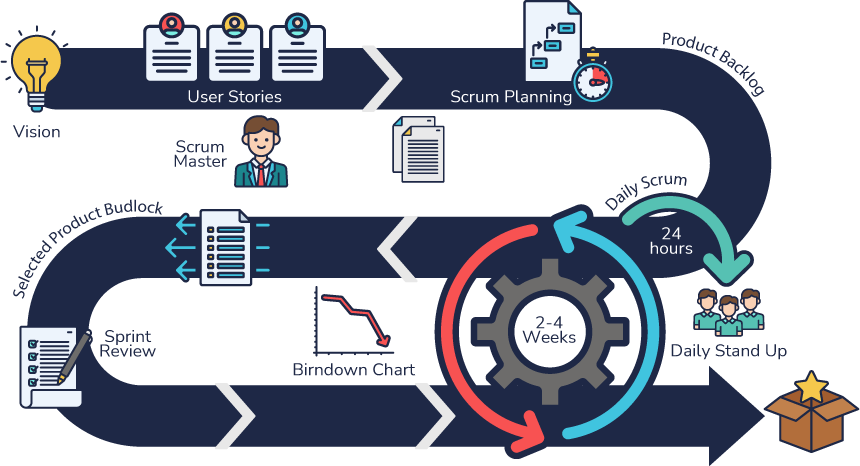The Product Owner together with the SCRUM Master clarify the requirements and prepare the product backlog which then is prioritized and divided into regular time slots called sprints. Within a sprint, the team evaluates the highest priority and most urgent tasks and delivers the updated product which is then demonstrated to the client’s product owner. This gives the client a few unique advantages:
- To control the direction of the product throughout the development process
- Escape from long blackouts of communication between the technology implementation team and product owners. This decreases the risks of misunderstanding and in most extreme scenarios can prevent the project from failure due to differences in understanding of the written specifications
- Most of the projects that include visual aspects (user interfaces) depend on User Experience. This is a highly subjective matter and in 9 out of 10 cases the product owner knows its clients and their preferences better than the technology team. Fast release cycles enable the product owner to steer away from poor design choices and correct the look and feel before the product launches.
- Pivoting is also very important. There is no project in the world that did not experience small or more significant change requests. This is normal as the market and the target public expectations are not fixed in time. Everything on the free market is a moving target thus being able to pivot the product to adjust to such changes without renegotiation of contracts and fast response can sometimes make or break the success of the project/product/effort.
- Cost control. Usually, the pitch against time and material projects are that lack of definite deadline and scope of work sounds scary for the end client. But when building relationships between the clients and our technology teams we make sure that the level of efficacy, productivity are high, while the level of technical debt is kept within the budgeted expectations. Time and material contracts are easier to work with and the product owner actually has direct control over delivery and costs. If the things (in an unlikely manner) do not work well the client will learn that after the first few sprints when comparing expectations and reality. Compared to that the waterfall projects will close down the team in order to escape from potential changes and produce a software solution that might not match the expectation, making the financial and product risk higher (not only in financial manners but also due to lost time to go to market). Even more, the ability to do soft and production tests with MVP (Minimal Viable Product) – a subset of product which can be valuable enough for the clients before official launch opens new potentials in marketing and sales including:
- Live market testing
- Pivoting based on market feedback
- Pre-sales become sales – beta testers sign up for subscriptions and start using the products years or months earlier than the alternative options or competition
- Market entry earlier than the competition
- A/B Testing
- Early cancellation if the market does not show the interest
- Style choice – fast go to market vs. heavily tested and documented release cycle – depending on budget and market expectations.

